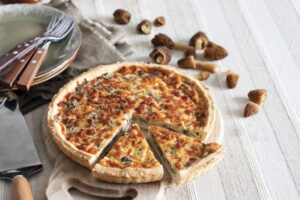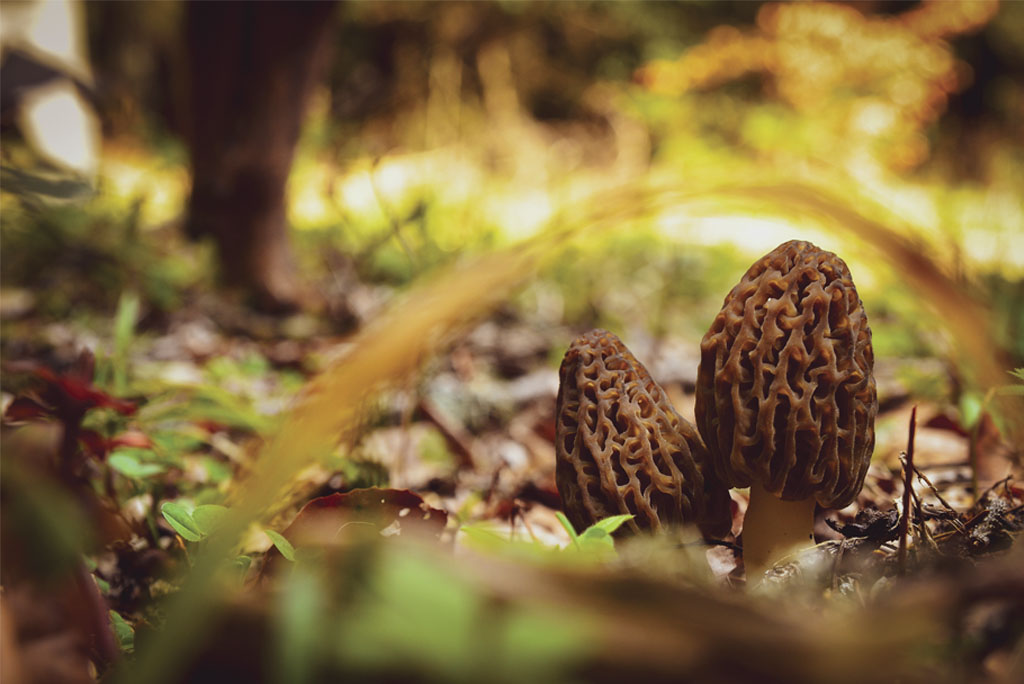At the same place, at approximately the same time every spring when damp forests shift into full blossom, mushroom foragers cautiously tiptoe about, pocketknives and baskets in hand. I’ve been one of them. My sister, a seasoned morel forager, took me morel hunting several years ago in mid-May.
We drove up an unmarked road on “the other side of the mountains” from Hailey, Idaho, at a much lower elevation to “no-name woods.” With our four young kids in tow, we set out to forage for an experience—not necessary to locate the “Motherload on Mother’s Day.”
The hunt for morels requires heightened senses. Ears attuned to the potential of other foragers in one’s self-proclaimed territory. Fingers brush aside pine needles or caress the tops of white puffball and caramel-colored bolete mushrooms—edible, yet less desirable than morels.
With winter’s chill fully in the past, the air is warm even in the shade and soil temperatures have increased enough for mushrooms to grow. Morel-friendly flowers unwrap their petals and essence: arnica, calypso orchids, glacier lilies, flowering dogwood and trillium. In Idaho’s mountains, a morel’s typical symbiotic community includes fir trees, not pines and, often, cottonwoods or huckleberry bushes (if you’ve mapped that undisclosed location, too).
Like entering a portal into nature’s richness, the secret to foraging is simple: spend time in the woods, move slowly, pack a lunch, carry water, practice patience and observe. And yet, don’t delay too much with morels—the season lasts only a couple of weeks. Persevere, and the prized honeycomb-capped fungus will expose itself to attuned “mushroom eyes.”
 When conditions are perfect, natural species of Morchella materialize from seemingly everywhere; when conditions are imperfect, morels appear in microclimates, such as tucked under fallen logs. If they’re small and popping up, go lower elevation for more mature morels or return in a week. If they crumble, they’re old—leave them.
When conditions are perfect, natural species of Morchella materialize from seemingly everywhere; when conditions are imperfect, morels appear in microclimates, such as tucked under fallen logs. If they’re small and popping up, go lower elevation for more mature morels or return in a week. If they crumble, they’re old—leave them.
Sometimes morels pop out from underneath a bed of pine needles, where there appears to be nothing else growing. They also like places where the soil has been disturbed, such as the edges of old logging roads or campfire rings.
Fire morels—also called “burn morels” or “black morels”—co-exist in nature differently than “natural morels,” which grow in the same spot each year. Fire morels are single-walled mushrooms (verses the 2-walled “natural” Morchella species) that grow in coniferous forests the year after a forest burn. They range in color from light brown to almost black.
However, if there’s red coloring anywhere on the mushroom, don’t pick it!
If there are ants or any other bugs, leave them. If the stem seems abnormally meaty (not hollow from step to the cap, like natural and fire morels), the head is “brain-like,” and it’s potentially a so-called “false” morel. These may be among many other mushrooms, of which Gyromitrin and Verpa are often mistaken for morels. While some people report they do not get sick from them, the toxins in Gyromitrin can cause short- or long-term illness. You must know what you’re harvesting! “When in doubt, leave them out,” cautions my sister.
When new to mushroom foraging, it’s unnerving to remember nature’s nuances. If possible, find a fungi person to help identify your harvest. She might not take you to her top-secret spot, yet she’s probably willing to help you find your own. Like my sister, she’ll teach you how to “flick and pick” (release the spores to ensure mushrooms grow the following year), how to gently slice the upper morel stem away from the base (with your thumbnail or a small knife), and how to know which morels to keep (and to leave a few morels in each area to “spore out”).
She’ll teach you how to keep “a clean basket” (don’t pick overly dirty morels) and remind you and your dog that you’re in the home of other animals (if dogs scare grouse, the grouse may not return to their nest).
Once home, carve out time to care for your bounty. Fire morels dry out more quickly than natural morels, so eat or dry them immediately. There’s no need to wash morels—they’ll become mushy and potentially moldy. Place the amount you plan to consume in the next few days in a bowl in the fridge; never store morels in a sealed container—they need to breathe. Dry the remainder.
To prepare fresh morels for cooking, simply tap them to release excess spores and debris, then slice larger mushrooms into ideal-sized pieces for your meal. Be as mindful with morel meals as you are with foraging. Choose wild, seasonal accompaniments, just as morels choose their ideal growing place. Some amazing recipes made with morels sauteed in butter with dandelion greens and pasture-raised eggs, morels include elk-morel stroganoff and morel-asparagus pizza.
When eating morels with plant-based foods—like wild rice with chopped purslane—ensure you include vitamin C-rich foods, like bell peppers, to help absorb the high amounts of iron in morels. Depending on the soil diversity upon which morels mature, the mushrooms may also be high in calcium, copper, magnesium, phosphorus, potassium and zinc minerals. Morels and other mushrooms are among the few food sources of vitamin D.
Despite their dense nutritional value, take caution with the amount of wild morels you consume, and always cook them thoroughly. Like many other foods from the earth, mushrooms contain small amounts of natural toxins—a protective mechanism. Wild morels contain hydrazine toxins (destroyed when cooked), yet some people still experience gastrointestinal upset. Nevertheless, morels benefit gut health with their soluble fibers, including galactomannans. They also can benefit liver function and the immune system thanks to antioxidant compounds like phenolic acids. However, some morels can be high in heavy metals due to chemicals saturating the soil.
If you’re new to foraging morels – or any wild Idaho mushroom, like blue oyster, cauliflower, king bolete, or meadow – mindfully harvest them from agriculture sprayed with pesticides. If you buy mushrooms, ensure they’re from a trusted source. Then, enjoy them in harmony with nature.
HOW TO DRY MORELS
Arrange the mushrooms on a tray or clean surface in a single layer, allowing them to dry in the open air. In arid Idaho, they’ll be dry in a couple of days. Don’t be in a hurry to put them into a container—you cannot “over-dry” morels, but you can seal them in a jar or bag too soon (in which case, they’ll mold).
Before adding dried morels to storage containers, place them in a bag and shake them to release dust or debris. Notably, any remaining spores also will release – they will look like white powder. Some people spread these spores in their own yards if there are ideal places for morels to grow the following year.
NOTE: The spores (powder) are hard to remove from drying trays. Therefore, soak the trays to remove excess spores with soap and hot water. Alternatively, use the tray only for dehydrating mushrooms and NOT other foods (you don’t want spores contaminating your kitchen or other foods).
WILD IDAHO SPRING PIZZA OR QUICHE
 Pizza night is a big deal in my house (I’m Italian and have kids, after all). To mix it up each week, I look for seasonal ingredients. Harvesting fresh morels practically begs us to source other ingredients from spring’s abundance. This recipe includes sourdough crust I make from scratch using my sister’s rosemary sea salt and Hillside Grain flour, raised and milled in Bellevue, Idaho. I also make pesto from scratch using local, seasonal greens and garlic. Feel free to source pre-made crust and pesto handmade in your area, and when you’re up for it, try making them from scratch, too.
Pizza night is a big deal in my house (I’m Italian and have kids, after all). To mix it up each week, I look for seasonal ingredients. Harvesting fresh morels practically begs us to source other ingredients from spring’s abundance. This recipe includes sourdough crust I make from scratch using my sister’s rosemary sea salt and Hillside Grain flour, raised and milled in Bellevue, Idaho. I also make pesto from scratch using local, seasonal greens and garlic. Feel free to source pre-made crust and pesto handmade in your area, and when you’re up for it, try making them from scratch, too.
Ingredients
1/2 lb. elk sausage (or another sustainably raised sausage of choice)
1/2-1 cup fresh morels (or 1/4-1/2 cup dried, that have been reconstituted in milk)
12 fresh asparagus spears
Pesto (to make your own, see “Easy Peasy Pesto” recipe in the Spring 2023 Taste of Sun Valley or online at sunvalleymag.com)
4-6 oz. fontina cheese, grated
(or locally made cheese of choice)
Olive oil (for greasing pizza trays)
Sourdough for two 12-inch pies (if you don’t make your own crust, buy sourdough crust locally, such as from Hangar Bread in Hailey)
Arugula or microgreens, for garnish (optional)
Instructions
Heat oven to 400 degrees F. Place the rack in the middle.
Prepare toppings.
Elk sausage
Heat a cast-iron skillet to medium heat and break apart fresh sausage into bite-sized pieces. Add your favorite seasonings, such as rosemary or garlic. Cook thoroughly until no pink is evident, about 8 minutes.
Morels
If using fresh morels, ensure they are dirt-and-bug-free (but don’t wash them). Slice into sizes of your choice. If reconstituting morels from dried, place morels in a small bowl with milk (water makes them soggy)) for about 10 minutes to rehydrate. When ready to use, strain well, pat dry, then slice.
Asparagus
Wash asparagus spears. Snap off the bottom ends. When the sausage has finished cooking, remove it from the skillet and place it in a separate bowl, keeping the fat and juices in the skillet to cook the asparagus. Sauté the asparagus, covered, for 5-6 minutes. If the skillet is too dry, add olive oil and/or water. Add a pinch of sea salt or pepper if you’d like. Asparagus is ready when it’s bright green and slightly crunchy. Remove from the skillet (otherwise, the hot skillet will keep cooking the asparagus). Considering the size of the crust, cut off the ends of each spear so you can artfully place the floret toward the middle of the pizza, with the ends reaching toward the crust.
Prepare crust.
If using fresh sourdough crust, first line the baking sheets/cookie trays with silicone or parchment paper and spread evenly with a small amount of olive oil. Using your fingers, spread half the dough into a circle on the oiled paper or silicone until it’s approximately 1/4-inch thick (it is fine if the edges are slightly thicker). Bake the first crust for 5-6 minutes, until it’s slightly firm to the touch to easily spread pesto on top. While the first crust bakes, spread out the remainder of the crust on the second sheet/tray, then bake for 5-6 minutes.
Assemble pizza.
While the second pizza crust is baking, spread the pesto (store-bought or homemade, see “Easy Peasy Pesto” recipe (see the spring 2023 issue of Taste of Sun Valley Magazine) evenly on the first crust. Add elk sausage, morels, and freshly grated cheese (if using goat cheese or feta, just crumble on top). Place asparagus spears in an artful way on top. Bake for 6-8 minutes until the cheese has melted and the crust becomes golden brown. Add toppings to the second crust while the first pizza is baking, then bake for 6-8 minutes until golden brown. Slize pizza and garnish with fresh arugula or microgreens. Enjoy!
Tip:
Double up on sausage, morels, asparagus, or cheese (or save extra) for a subsequent meal—these ingredients make an incredible omelet or quiche (see the “Simple Quiche” recipe in the Spring 2023 issue of Taste of Sun Valley Magazine)!


